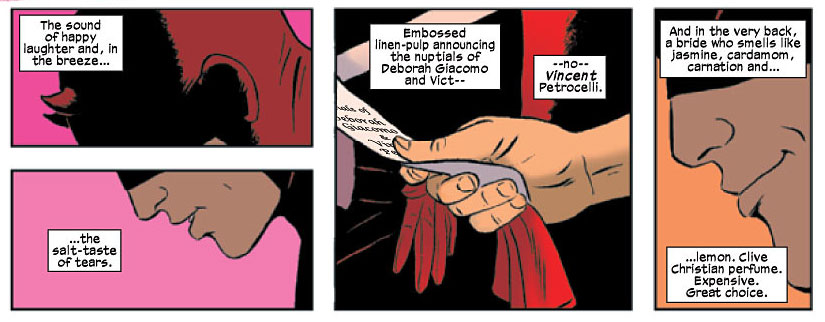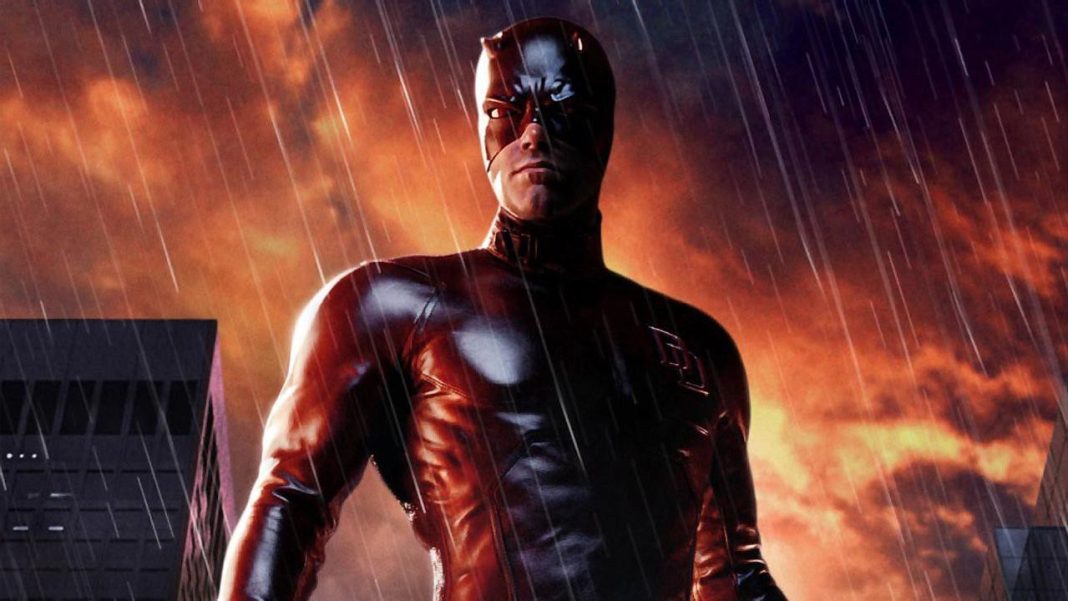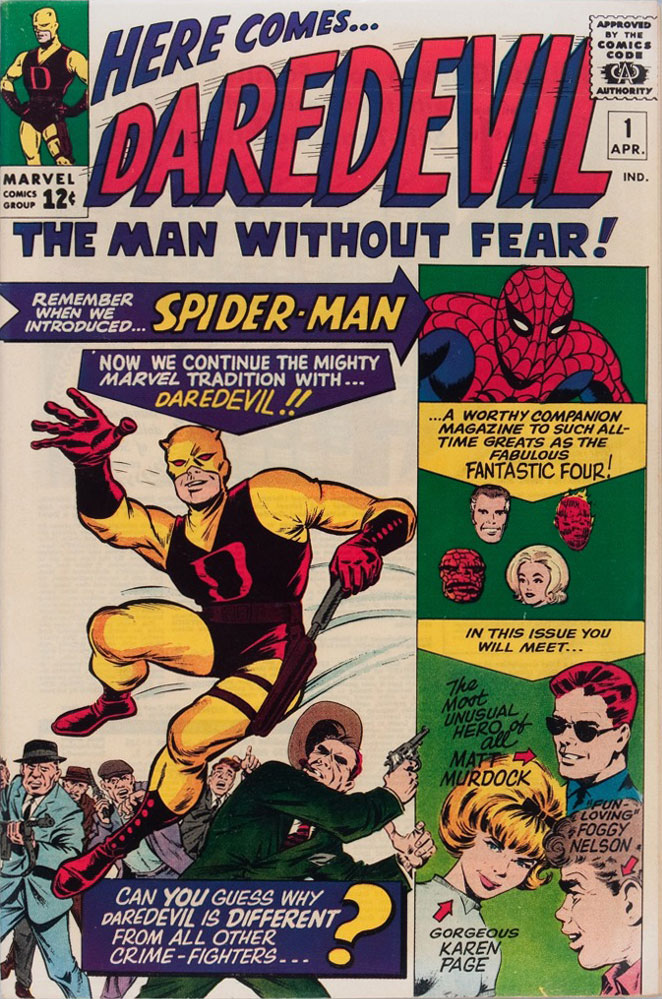The Beat’s Gregory Paul Silber has been accused of having a bit of an… obsessive personality. Each week in Silber Linings, he takes a humorous look at the weirdest, funniest, and most obscure bits of comics and pop culture that he can’t get out of his head.
The 2003 Daredevil film starring Ben Affleck in the title role came out at the perfect time to be formative for me. While I didn’t get a chance to see it in theaters, I rented the DVD from Blockbuster as soon as I could just a few months later and was blown away. It had everything a 12-year-old boy could want from a movie in the early aughts: superheroes, flashy fight scenes rife with slow-mo, a nu-metal soundtrack, and Jennifer Garner looking like the hottest woman I had ever seen in my dozen years of life. Unfortunately, it wasn’t long before I found out the film had a less-than-sterling reputation. So while I lost track of the number of times I saw Daredevil in my middle school years, I hadn’t watched it again until this week, almost two decades later. I didn’t want to ruin those good memories, but I was willing to risk it for a good piece of Silber Linings content.
Fortunately, I’m happy to report that my suspicions were correct: Daredevil (2003) is far from a masterpiece, but it still rules.
Context time: while Daredevil/Matt Murdock is my favorite Marvel superhero, and my second favorite superhero overall after Batman, he’s generally not considered one of Marvel’s top-tier characters like Spider-Man, Wolverine, or The Hulk. The blind lawyer by day turned acrobatic vigilante by night had a troubled history from the start: after debuting in 1964’s Daredevil #1 by writer/editor/alleged-fraud Stan Lee and artist Bill Everett (with some design help from Jack Kirby), the latter’s failure to keep up with deadlines caused him to be replaced by Joe Orlando by the second issue, with Wally Wood coming in by #5 and soon replacing DD’s original yellow costume with the iconic red suit that’s most recognizable today, including in the 2003 movie.
By the late 1970s, the Daredevil comic was on the verge of cancellation before a young artist named Frank Miller joined the title, even stepping in as the writer when editor Denny O’Neil fired Roger McKenzie. Aided by celebrated inker Klaus Janson, Daredevil became one of the most acclaimed comics of the 1980s. Other popular runs followed. The 1998-1999 “Guardian Devil” arc, for example, written by Kevin Smith (yes, that Kevin Smith) and penciled by future Marvel Creative Director Joe Quesada is largely credited with helping save Marvel from bankruptcy.
Still, by 2003, I’d wager that the vast majority of folks had never heard of Daredevil before the release of the film written and directed by Mark Steven Johnson. DD had a few non-comics appearances in the decades prior, including in live action alongside The Incredible Hulk and in kids cartoons via Spider-Man: The Animated Series, but poor Matt Murdock didn’t have nearly the amount of mainstream clout that The X-Men and Spider-Man did by the time they made their feature film debuts in 2000 and 2002, respectively.
I suspect that the character’s lack of A-list status, paired with the timing of the film’s release, led to the perception, however erroneous, that Daredevil was a cheap Spider-Man knockoff. Sam Raimi‘s original Spider-Man, released on May 3rd, 2002, was not just a mega-hit, but a cultural phenomenon (and for this critic, a genuine life-changing experience). Daredevil was released barely nine months later on Valentines Day in 2003. Anyone remotely aware of how long it takes to produce a film would know it’s not plausible to suggest Daredevil was merely a Spider-Man cash grab, but consciously or not, that viewpoint caused a lot of people to be less favorable towards Daredevil in their Spider-Man comparisons than it deserved. You’d be hard-pressed to find contemporaneous Daredevil reviews that didn’t mention Spider-Man.
To be fair, the characters themselves are rather similar. Daredevil and Spider-Man are both New York City-based superheroes whose acrobatic abilities allow them to treat Manhattan as an obstacle course and playground, which of course is a massive part of their appeal (and why they’re so much fun to see together when they team up in the comics). Even their costumes are a bit similar, as is the angst that characterizes both Peter Parker and Matt Murdock. The Matrix‘s influence on the early-’00s zeitgeist is palpable in both films, with multiple sequences of the title characters flipping around to dodge various projectiles in slow-motion, but you won’t hear me complaining about that.
I’m also convinced that Ben Affleck’s status as a tabloid favorite unfairly hurt Daredevil‘s reputation, even if Affleck himself has said he hates the movie. Not long after winning an Oscar for Good Will Hunting alongside Matt Damon, the height of Affleck’s career was followed by a vicious backlash thanks to paparazzi culture. I’m not saying everything he’s ever done, or every movie he’s ever starred in, has been flawless, but looking back at that era, it’s strange how Affleck was considered such a punchline because… why? Because he had a relationship with Jennifer Lopez and did a bad movie or two with her? Suddenly that negates all his other accomplishments? He still hasn’t fully escaped his punchline status, as we can see from his recent Razzie nomination for his role in The Last Duel despite giving the best performance in that whole film. Affleck gives a fine performance as Daredevil. Not his best, but it’s better than his Batman role in those Zack Snyder movies, I can tell you that much.
Daredevil (2003) is no Spider-Man (2002), as even my 12-year-old self could have told you. The characters (other than DD himself, arguably) are two-dimensional at best, the sprinkling of CGI hasn’t aged well, and the script doesn’t have much depth. But in rewatching Daredevil for the first time in almost two decades, I tried to approach it less like a critic and more like an archaeologist of my own psyche. “What’s going on here that spoke so directly to me at that age?”
The most obvious answer is that it kicks ass. I’ve written briefly about this before, but as much as I appreciate the 2015-2018 Daredevil streaming series for what it is, it never showed much interest in depicting Daredevil as, well, a daredevil (yeah yeah, I know there’s only so much budget in a TV show to go around). The film, meanwhile, uses a combination of deft stuntwork with limited CGI to emphasize the excitement of a blind “man without fear.” This Daredevil slides down poles, jumps from rooftop to rooftop, runs along walls, and uses his signature billy club to swing from flagpoles much like a certain Spider-themed colleague. I love a good fight scene, and Daredevil has better action than the vast majority of MCU projects with bigger budgets and better reviews.
The visual depiction of Matt Murdock’s “radar sense” is imaginative too, if a bit video-gamey as far as special effects go. Not only does it make for some cool moments in the fight scenes as Daredevil anticipates attacks and dodges bullets, but it’s used to strong dramatic effect as well. The writing of Daredevil’s relationship with Elektra (Garner) is a bit skeevy at times, but Affleck has strong chemistry with his future wife (and later ex-wife) during a romantic scene in which the rain helps Matt “see” Elektra for the first time. Later, during the funeral for her father, Elektra rebukes Matt’s attempt to comfort her by opening an umbrella as rain begins to fall. It’s not subtle, but it works. And it really speaks to Daredevil’s central appeal as a disabled superhero: that give and take between an empowered Matt overcoming his limitations, and the sad acknowledgement that his life will never be what it was before the accident that took his sight.

I wasn’t yet a comic book reader when I saw Daredevil as a child, so it was interesting to revisit it now that I’ve read so much of the source material. There are some fun Easter Eggs that went right over my head as a kid, including creators like Bill Everett, Brian Michael Bendis, and David Mack getting namechecked, as well as cameos from the likes of Frank Miller, Stan Lee (duh), and Kevin Smith (playing a character named “Kirby”). It is strange, though, that the rapist at the beginning of the film played by Paul Ben-Victor is named “Jose Quesada.” I wouldn’t have thought that was funny if I were Joe Quesada, but what do I know; I’ve never been the Editor-in-Chief of Marvel Comics.
There are some deviations from the source material, but nothing that misses the point on the level of Batman killing people with guns. Colin Farrell‘s version of Bullseye has little in common with the comics version beyond the central “good at aiming” gimmick, but Farrell plays him with such ferocious campiness that it’s too fun to complain about. Matt’s ears are too sensitive, and his tastes too refined, for me to buy that he’d be into post-grunge butt rock bands like Seether and Saliva, but I’m not going to blame a 2003 film for sounding like 2003 (those Evanescence songs still slap, though). Most egregiously, I don’t buy that Daredevil would ever ignore the sound of people in peril, even when Elektra wants to have PG-13 sex with him, but who am I to begrudge anyone taking up Jennifer Garner on an invitation to spend the night.
For the most part, though, Daredevil (2003) captures what I love about the title character: his life is a mess (and he’s a terrible boyfriend), but he’s passionate about justice, speaks truth to power, and doesn’t let his physical disability or emotional baggage stop him from helping those in need. Plus, he kicks butt, his costume is cool, and he has fun quips. There are dozens of superhero movies I’d recommend before Daredevil, but it’s still an entertaining action flick from a bygone era.










Colin Farrell’s Bullseye and Michael Clarke Duncan’s Kingpin are by far the best parts of the movie.
I planned on seeing the movie but just before leaving my house, I had on Siskel & Ebert, the movie review show. They reviewed Daredevil. Both liked it. At the very end, Roger Ebert said that is was a very good movie. Then, he put his thumb and forefinger an inch apart and said it was THIS far from becoming a GREAT movie. I went to the theatre and saw it and I agreed.
Comments are closed.